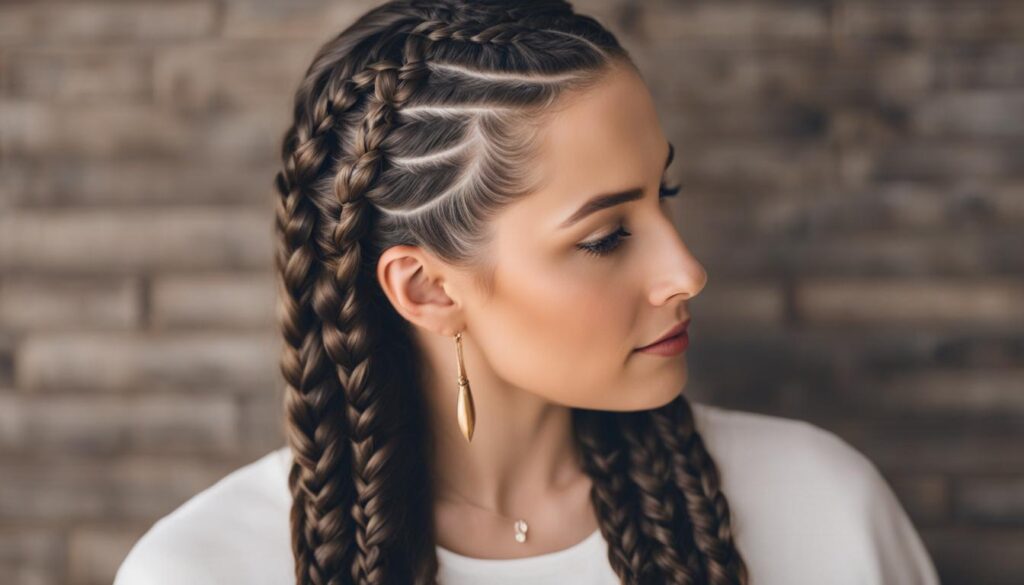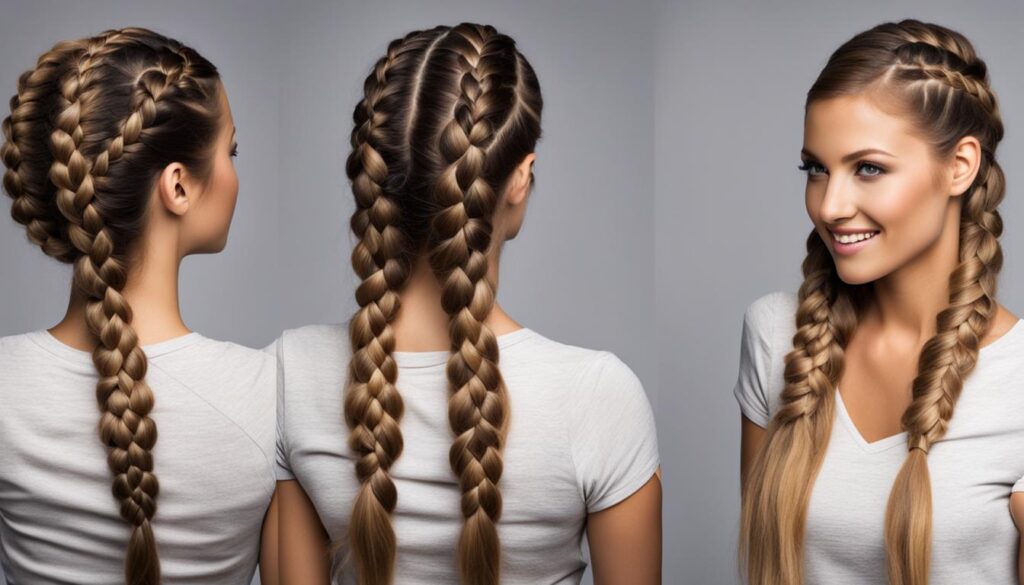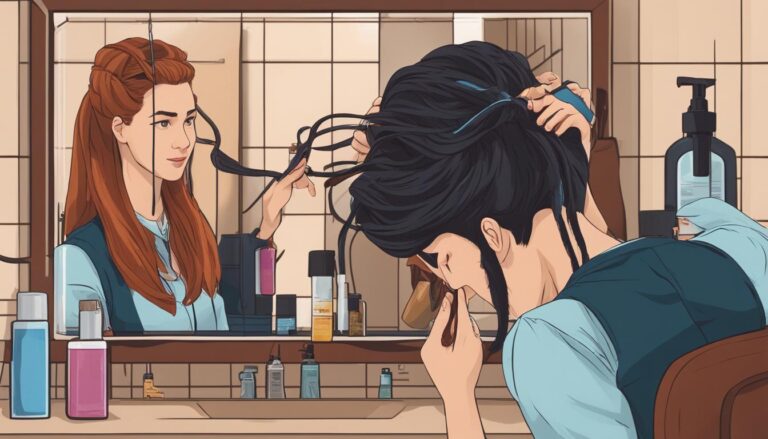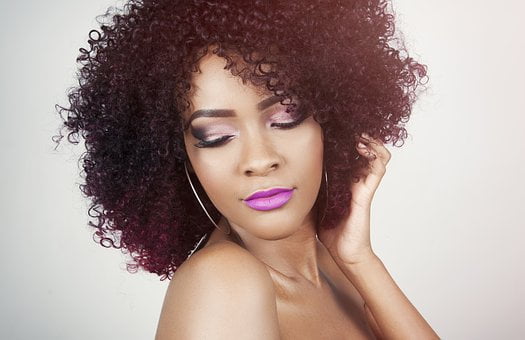What Do Dutch Braids Look Like?
Dutch braids, also known as 3D braids or reverse braids, are a unique style of braids that differ from French braids. Instead of crossing the strands of hair over each other, Dutch braids involve crossing them under, creating a plait that pops out. Dutch braids are versatile and suitable for any occasion. They can be adapted to different hair types, textures, and lengths. In this article, we will explore various Dutch braid hairstyles and variations.
Key Takeaways:
- Dutch braids are a unique style of braids that involve crossing the strands under, creating a plait that pops out.
- They are versatile and suitable for any occasion, and can be adapted to different hair types, textures, and lengths.
- In this article, we will explore various Dutch braid hairstyles and variations.
How to Create Dutch Braids: Step-by-Step Tutorial
Creating Dutch braids may seem intimidating at first, but with a step-by-step tutorial, it becomes much easier. Follow these simple instructions to achieve beautiful Dutch braids:
- Prepare your hair: Start by brushing your hair to remove any tangles and knots. This will make it easier to work with.
- Divide your hair: Use a comb to create a clean, straight part down the middle of your head, from forehead to nape. This will divide your hair into two sections.
- Begin braiding: Take a small section of hair from the front of your left section. Divide it into three equal parts.
- Cross under: Instead of crossing the sections over each other like in a traditional braid, cross the right strand under the middle strand, and then cross the left strand under the middle strand.
- Add more hair: As you continue braiding, add more hair to each section before crossing them under. This creates the distinctive 3D effect of Dutch braids.
- Repeat the process: Continue braiding and adding hair until you reach the nape of your neck.
- Secure the braid: Once you’ve reached the desired length, continue braiding without adding more hair and secure the end with a hair elastic.
- Repeat on the other side: Repeat the same process on the right section of hair to create a matching Dutch braid.
With practice, you’ll be able to create Dutch braids effortlessly and experiment with different variations. Don’t be discouraged if your first attempt isn’t perfect. It takes time to master the technique, but the results are well worth it! Remember to have patience and enjoy the process of learning and creating beautiful Dutch braids.
Dutch Braid Variations
Once you’ve mastered the basic Dutch braid, you can explore various variations to add more style and creativity to your hairstyles. Here are a few popular Dutch braid variations to try:
- Dutch fishtail braid: This variation combines the elegance of a fishtail braid with the unique 3D effect of Dutch braids. Instead of dividing the hair into three sections, divide it into two and intertwine them with the undercrossing technique.
- Dutch crown braid: Create two Dutch braids on each side of your head and wrap them around the crown of your head, securing them with bobby pins. This creates a beautiful crown-like effect.
- Double Dutch braids: Divide your hair into two equal sections and create two Dutch braids on each side of your head. This hairstyle is perfect for a sporty and chic look.
These are just a few examples of Dutch braid variations. Feel free to experiment with different styles, accessorize with ribbons or flowers, and make the braids your own. The beauty of Dutch braids lies in their versatility, so don’t be afraid to get creative!
Dutch Braid Hairstyles for Different Occasions
If you’re looking for versatile and stylish hairstyles for different occasions, Dutch braids are a perfect choice. These braids can be customized to suit your personal style and can be worn casually or dressed up for more formal events. Whether you’re a beginner or a seasoned braider, there are endless possibilities with Dutch braids.
For a chic and effortless look, try a half-up Dutch braid. This hairstyle is perfect for a casual day out or a brunch with friends. Simply create two Dutch braids on the top half of your hair and secure them with bobby pins at the back. This style keeps your hair out of your face while adding a touch of boho elegance.
If you’re attending a special event such as a wedding or a prom, consider a Dutch braided updo. This elegant hairstyle is created by braiding your hair into Dutch braids and then twisting them into a low bun or a braided crown. It’s a timeless look that is sure to turn heads and make you feel like a queen.
Quotes:
“Dutch braids are the perfect choice for any occasion. They add an element of sophistication to your look while being easy to recreate.” – Hair stylist
Dutch Braids for Beginners:
- Start with clean, dry hair.
- Divide your hair into two equal sections.
- Take a small section of hair from the outer edge of one section and cross it under, adding it to the opposite section.
- Repeat the previous step with the other section, crossing a small section of hair under and adding it to the opposite section.
- Continue crossing small sections of hair under and adding them to the opposite section until you reach the end of your hair.
- Secure the end of your braid with a hair elastic.
With a little practice, you’ll be able to create beautiful Dutch braid hairstyles for any occasion. Experiment with different variations and accessories to make the style your own. Remember, the key to achieving the perfect Dutch braid is patience and practice.

Supplies for Creating Dutch Braids
Creating Dutch braids requires a few essential supplies to ensure a smooth and successful braiding process. Here are the supplies you’ll need:
- Hair brush: A hair brush is essential for detangling your hair and removing any knots or tangles before starting your Dutch braids.
- Comb: A fine-toothed comb is helpful for creating clean and precise partings in your hair, ensuring that your Dutch braids are neat and well-defined.
- Hair elastics: You’ll need a few hair elastics to secure your Dutch braids. Opt for clear or color-matched elastics to blend seamlessly with your hair.
- Bobby pins: Bobby pins can come in handy for securing any loose strands of hair or for creating intricate styles with your Dutch braids.
- Styling products: Depending on your hair type and desired look, you may want to use styling products such as hairspray, mousse, or a texturizing spray to add hold, volume, or texture to your Dutch braids.
With these supplies at hand, you’ll be well-prepared to create beautifully crafted Dutch braids.
Pro Tip:
Before starting your Dutch braids, it’s helpful to have all your supplies within reach to ensure a seamless braiding process. This way, you won’t have to pause midway through to search for a missing hair elastic or bobby pin.
Tips and Tricks for Perfecting Dutch Braids

Creating perfect Dutch braids may seem challenging at first, but with practice and the right techniques, you’ll master this beautiful hairstyle. Here are some tips and tricks to help you perfect your Dutch braids:
1. Start with Clean and Tangle-Free Hair
Before attempting to create Dutch braids, make sure your hair is clean and free of tangles. Use a gentle shampoo and conditioner to ensure your hair is smooth and manageable. Brush your hair thoroughly to remove any knots or tangles, as they can make the braiding process more difficult.
2. Section Your Hair Properly
Divide your hair into two equal sections, starting from the top of your head. Use a comb to create a straight part down the middle, separating your hair into two halves. Secure one section with a hair elastic to keep it out of the way while you work on the other side.
3. Cross Under, Not Over
Unlike French braids, Dutch braids involve crossing the strands under each other. Take a small section of hair from the outer edge of the bottom section and cross it under the middle section. Repeat the same process on the top section, crossing the hair under the middle. Continue this pattern, adding more hair to each section as you go, until you reach the nape of your neck.
Tip: To create a 3D effect, pull the strands of each section upwards as you cross them under. This will make your Dutch braids stand out and give them a voluminous appearance.
By following these tips and tricks, you’ll be well on your way to mastering Dutch braids. Remember, practice makes perfect, so don’t be discouraged if your first attempts aren’t flawless. With time and patience, you’ll be able to create stunning Dutch braid hairstyles that are sure to turn heads.
Conclusion
Dutch braids are a popular choice when it comes to braided hairstyles. They offer a unique twist to the traditional French braids, with their distinctive crossing-under technique that creates a stunning 3D effect. Whether you’re a beginner or an experienced braider, Dutch braids are versatile and suitable for any occasion.
With Dutch braids, the possibilities are endless. You can experiment with different variations and styles to create stunning looks that suit your personality and taste. From elegant braided updos to casual half-up hairstyles, Dutch braids can be adapted to any hair type, texture, and length.
To achieve perfect Dutch braids, it’s important to have the right supplies, such as a hair brush, comb, hair elastics, bobby pins, and styling products. Additionally, practice and patience are key. The more you practice, the better you’ll become at creating flawless Dutch braids.
So, embrace the beauty of Dutch braids and unleash your creativity. Explore the world of braided hairstyles and discover the endless styling possibilities. Whether you’re attending a special event or simply want to add a touch of elegance to your everyday look, Dutch braids are a fantastic choice. So go ahead, grab your supplies, and start braiding your way to fabulous hair!
FAQ
What do Dutch braids look like?
Dutch braids are a unique style of braids where the strands of hair are crossed under each other, creating a plait that pops out. They are also known as 3D braids or reverse braids.
How do I create Dutch braids?
Here is a step-by-step tutorial on how to create Dutch braids:
What are some Dutch braid hairstyles for different occasions?
Dutch braids can be styled in various ways for different occasions. Some ideas include braided buns, braided crowns, and half-up Dutch braid styles.
What supplies do I need to create Dutch braids?
To create Dutch braids, you will need the following supplies: a hair brush, a comb, hair elastics, bobby pins, and styling products like hairspray or hair gel.
Do you have any tips and tricks for perfecting Dutch braids?
Yes, here are some tips and tricks for perfecting your Dutch braids: practice on clean, detangled hair, use smaller sections of hair for a more defined braid, and secure the ends of the braids with hair elastics or bobby pins.
Can anyone create Dutch braids?
Yes, Dutch braids can be created by anyone, whether you’re a beginner or an experienced braider. With practice and patience, you can achieve stunning Dutch braid hairstyles.







